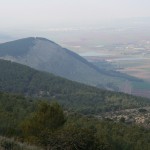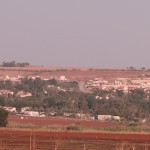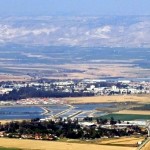Examples Using the Route Manager
All of these Plugins and more are included in our Yearly Membership plan
- Created: October 30, 2015 10:22 am
- Updated: March 7, 2023 10:15 am
- Distance 9612 m
- Duration 2 h 23 min
- AVG speed 4.0 km/h
- Min altitude -84 m
- Peak 246 m
- Climb 422 m
- Descent 403 m
- Distance Instructions
Mount Gilboa sometimes called the Mountains of Gelboe, is a mountain range overlooking the Jezreel Valley in northern Israel. The meaning of the name Gilboa is boiling springs; bubbling fountains; agitated pools; water bursting from the rock.
In the Bible, King Saul, Israel's first King, led a charge against the Philistines at Mount Gilboa (1 Samuel 28:4)
Every year from late February until late March the purple Hayne's Iris, known in Hebrew as the Gilboa Iris, blooms on the mountain
Images are Licensed under CC BY-SA 3.0 via Commons and are taken from Wikipedia. Attribute by Beivushtang
1. Kibutz Bet Hashita
Beit HaShita (in Hebrew it means House of the Acacia) is an Israeli kibbutz situated between Afula and Beit She'an. It was founded in 1935. The kibbutz was later named after the biblical town Beit Hashita, where the Midianites fled after being beaten by Gideon (Judges 7:22),[14][15] thought to be located where Shatta was. It falls under the jurisdiction of Gilboa Regional Council.
Image Licensed under Public Domain via Commons
2. Emek Beit Shean Fish Polls
Growth in fish ponds from the late 1930s.
The main fish:
Carp is (carp - Cyprinus carpio - Commn carp)
Eye trout - rainbow (trout, your name - Oncorhynchus mykiss - Rainbow trout)
Golden Spruce (Dennis, Charles Bird - Sparus aurata - Gilt-head sea bream)
Image "BeitShean" by Refael - Self-photographed. Licensed under CC BY 3.0 via Commons
3. Tel Yosef Old Village
Tel Yosef is a kibbutz in north-eastern Israel. Located in the Jezreel Valley, it falls under the jurisdiction of Gilboa Regional Council. In 2006 it had a population of 371. The kibbutz was established in 1921 by members of Gdud HaAvoda, and was named after Joseph Trumpeldor. It was located on Sheikh Hassan hill which is currently a monument to the old location of the Kibbutz which has moved since then to a new location
4. The Hidden Crick
The hidden crick is a climb going on the way toward mount Barkan in the gilboa.
Image taken from iNature
6. Semel Spring
Ein Semel is a spring located near the cliffs of the Gilboa. Alongside the spring you can find a big fig tree, and there will also meet a memorial to late Moshe Rosenfeld, who is considered the first kill of the "Arab Revolt in 1936-1939".
Moshe Rosenfeld was a sergeant in the British police which was killed in the beginning of 1936.
Image taken from iNature
7. Japanese Garden in Heftziba
Heftziba is a kibbutz in northern Israel. Located on the boundaries of the Jezreel and Beit She'an Valleys between the cities of Afula and Beit She'an, it falls under the jurisdiction of Gilboa Regional Council. Kibbutz Heftziba has a population of 374.
The Japanese Garden were established by the Makuya students which have been sent to Israeli kibbutzim to work together with the people of the Bible, and to study Hebrew and the biblical background. Some of them continue their academic studies in universities. The primary kibbutz the Makuya students stay at is Heftziba.
Here is a youtube video
Mount Gilboa sometimes called the Mountains of Gelboe, is a mountain range overlooking the Jezreel Valley in northern Israel. The meaning of the name Gilboa is boiling springs; bubbling fountains; agitated pools; water bursting from the rock.
In the Bible, King Saul, Israel’s first King, led a charge against the Philistines at Mount Gilboa (1 Samuel 28:4)
Every year from late February until late March the purple Hayne’s Iris, known in Hebrew as the Gilboa Iris, blooms on the mountain
Images are Licensed under CC BY-SA 3.0 via Commons and are taken from Wikipedia. Attribute by Beivushtang









